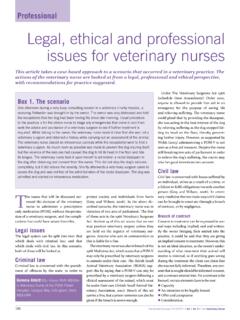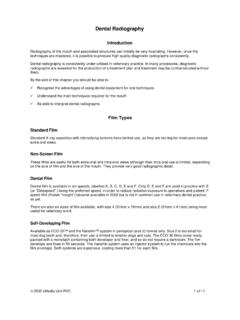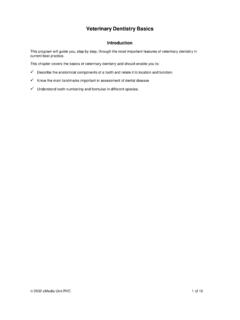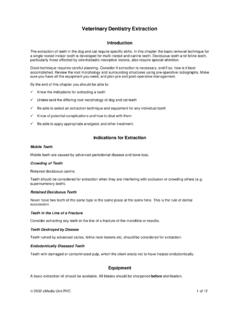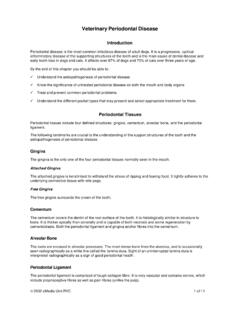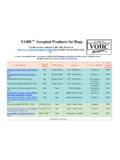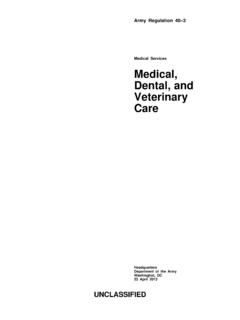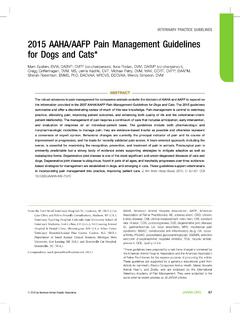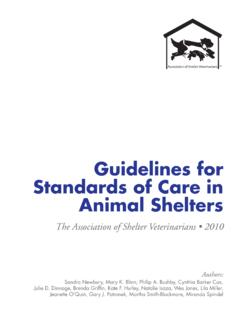Transcription of Experience of designing and implementing a care plan in ...
1 Education534 November 2012 Vol 3 No 9 The veterinary NurseVeterinary nursing has progressed immensely over the last half century (Pullen, 2006), gaining increased recognition. In 1991 amendments were made to Schedule 3 of the Vet-erinary Surgeons Act 1966 which enabled veterinary nurses (VNs) to be recognized by law (Pullen, 2006). The movement away from the previous hand-maid-en image is undisputable and VNs of today fulfil a respected role, and veterinary surgeons depend on them for their practical and knowledgeable support in the successful care of animals. The profession continues to progress forward and follows closely in the footsteps of its human nursing counterparts. It is no longer acceptable to practice along the lines of tradition and justify protocol by we have always done it this way (McSherry et al, 2002: 2). Medical nurses have acknowledged the impor-tance of their role in maintaining an up-to-date evi-dence base in their profession (Smirnoff et al, 2007).
2 Similarly, VNs are beginning to recognize that best practice needs to be specific to the veterinary field, incorporating expertise, Experience , as well as clinical judgement. The veterinary nursing evidence base is currently relatively limited and much information has been transferred from medical research. This is rap-idly improving due to advanced training courses, such as the Graduate Diploma in Professional and Clinical veterinary Nursing offered by the Royal veterinary College. This course encourages and emphasizes the need for evidence-based practice. The successful ini-tiative for the peer-reviewed veterinary nursing jour-nal The veterinary Nurse provides opportunity for VN research to be shared within the nursing process and nursing modelsAs well as forming an evidence base of its own, the pro-gression of the veterinary nursing profession has led to the modification of the way in which veterinary nursing is approached, hence the nursing process.
3 This theory broadens the outlook of patient care and encourages VNs to consider all aspects of the patient s wellbeing, rather than focusing solely on the disease or injury of the patient (Pullen, 2006; Chandler et al, 2007). The nursing process facilitates nursing and pro-vides a framework on which a systematic approach of care can be made for every patient (Chandler et al, 2007; H yrinena et al, 2010). A variety of interpreta-tions of the nursing process has resulted in the in-troduction of several different nursing models being successfully introduced in human nursing over the years; for example, Orem s Self care Deficit Model, Roper-Logan-Tierney Activities of Living Model and Peplau s Shared Experience Model (Pearson et al, 1998). The production of nursing interventions is achieved slightly differently for each model, but ultimately the focus of each encompasses all round patient idea that nursing care should take a different approach to medical intervention is not novel, as Jef-fery (2006) highlighted with Florence Nightingale s (1859) view that medicine and nursing are separate entities.
4 The nursing models provide the necessary framework for nurses to implement this enhanced approach to nursing care , in the form of a nursing care plan (NCP) (Main, 2011a), and thus move away from the medical approach that unfortunately can be Experience of designing and implementing a care plan in the veterinary environmentAbstractThe adoption of nursing care plans (NCP) within veterinary nursing has provided significant opportunity for movement away from the traditional medical model, towards a more holistic approach of nursing. NCPs provide guidance for veterinary nurses to implement nursing theory and the nursing process. Current literature regarding NCPs within the veterinary environment provides evidence for their posi-tive effect on animal care . However, published material on this subject is limited within the veterinary workplace. Unfortunately the lack of appreciation for the benefits of using NCPs within the human nursing field continues to influence the general opinion towards the use of these documents in the veterinary field.
5 The NCP discussed in this article was initiated a week after admission of the patient, therefore allowing excellent opportunity for comparison of the nursing interventions and care to be made prior to and following the introduction of the NCP. The views and comments of all the nursing staff involved with this patient and the NCP have also been : care plan, nursing process, profession, holistic, modelCharlotte Brown BSc RVN is Head veterinary Nurse at The Vets Salisbury, UK. This article was produced as part of her studies for the Royal veterinary College Graduate Diploma in Professional and Clinical veterinary veterinary Nurse Vol 3 No 9 November 2012 535 Educationtypically adopted in nursing. So why, since the mid 1970s, has there been increasing discussion regarding the value of nursing models (Wimpenny, 2002)? In the past NCPs have been viewed negatively by some human nurses, which has subsequently led to their minimal use in practice and little appreciation of their true worth and potential contribution to everyday nursing (Mason, 1999).
6 Recent publications by Lock (2011) and Wager (2011) discussed the ben-efits that NCPs can bring to the veterinary environ-ment if they are appropriately selected and tailored to suit the practice needs. Therefore, choosing and potentially modifying a care plan could be the key to successful and designing a care planThe Ability Model by Orpet and Jeffery (2007) is the only veterinary NCP framework to date (Lock, 2011). This model was chosen to form the basis of the care plan created for Ludo , an 11-month-old cat hospital-ized following a road traffic accident (Figure 1). Using Orpet and Jeffery s ten abilities helped to encourage a less medical approach considered by the author to be a more appropriate way to address Ludo s specific nursing issues. The research published by Lock (2011) and Wager (2011) was also considered when selecting the Ability Model was modified and the feature of the dependence independence continuum addi-tion, from the Roper-Logan-Tierny s Model (RLT) was incorporated.
7 It was thought that highlighting a patient s status of dependence independence clearly on the initial assessment would enable the specified activities to be clearly brought to the veterinary nurs-ing team s attention at a glance. It is imperative that the document is adapted to suit those who set out to use it for the benefits to be most effective and com-pliance to be maintained (Mason, 1999; Wimpenny, 2002). Equally, Orpet and Jeffery have recognized this and encouraged the modification of the Ability Model (Orpet and Jeffery, 2007) to improve workabil-ity within the practice environment. In accordance with the nursing theory, a nurs-ing assessment was carried out on the morning the NCP was produced, which was 6 days after Ludo had been admitted (Figure 2). A nursing assessment col-lects the information required to produce an accurate NCP (Mason, 1999). As Ludo had been signed over to the practice, it was not possible to ask his owners his usual habits in the form of a nursing questionnaire.
8 Orpet (2011) explained this lack of information is sub-optimal because without knowing what is normal Education536 November 2012 Vol 3 No 9 The veterinary NurseCare planTo be completed once daily or more often if requiredDateProblemShort term goalNursing interventionsReview time/dateEvaluation26/09/11 Pain: when moves due to unstable pelvic fractures and neurological painReduce movementPain score q 2hr. Minimize stimulation of Ludo to try to move himself and minimize need for ludo to be moved from kennel exam in kennel when possible. Gentle massage of both hind legs and range of movements in joints 3 x daily while still tenderAssess Q 2 effectiveness of pain management daily with massage 3 x dailyNutrition: RER not being met delayed healing, weight loss and muscle wastage2. HydrationDaily RER (205 kJ) to be met each day to avoid weight lossMaintain hydration levels2 alutray s of Purina Recovery (energy dense food with good quality protein) to be fed 6 x daily 2 x trays to be fed each day.
9 B/collar removed and supervised when eatingFeed wet food and monitor hydration levels. Offer water in bowl and monitor input. Continue IVFTQ 2 3 hrs during working hours and 11 pm at before bed check Evaluate hydration level Q 2 hrs and report to vet if concerned. May need to alter IVFT rate. Check breathing (sounds, rate), pulses etc. for over-hydration aswellSpecified feeding times improved quantity of food eaten. RER met today, this frequency to still not drunk from bowl, hydration maintained by IVFT and wet food. To continue this rate (maintenance), wet food and monitoring Q 2hrsCystostomy tube in place leading to potential problems of: 1. Obstruction by twisting of tubing 2. Pierce foley catheter deflate balloon holding catheter in place3. Local infection at site of insertion through abdo wall and/ or UTI4. Restricted movement in kennel because attached to urine collection bag potential to pull foley catheter outAvoid twistingDo not allow foley catheter to be puncturedAvoid infectionUrinary collection device not to get caught in kennel door restricting movement/ exerting forceUntwist asap if twist and ensure flow of urine into collection bagB/collar to be worn at all times and supervised closely when removed.
10 Avoid movement when b/collar not on because Ludo bites everything when in painOnce daily bathe local site with dilute Hibi, dry well and treat aseptically. Admin ABs twice daily POLoosen collection tubing as much as possible without tangling around LudoCheck for twisting Q 1hr and weigh urine collection bag Q 2 hrs. Should increase by approx 10 for leaks Q 2hrs and after painful panic attack if occursQ 24 hrsUrine cytology to check for infection (active infection with intracellular bacteria) Q 2 3 daysQ 2 hrs and each time kennel door closedUrine output met requirements. Weighing bag useful because cystotomy tubing twisted by Ludo on several occasions pierced urinary tubing and puncture repair required. Repaired area checked for leaks. Importance to control Ludo s pain/movement emphasized Great care taken when bathing insertion site. ABs taken well did get tangled so checked more often, at least Q 1 hrConstipationSoften stools to enable natural eliminationAdmin Laxapet 3 x daily and gently manually remove F with finger if visible in anusReassess Q 24 hrsPlan for enema when GA for x-rays tomorrow because minimal FHyperthermiaResume normothermiaCheck tempCheck temp Q 2 hrs, liase with vet if normothermia does not resumeHyperthermia + at end of day.
